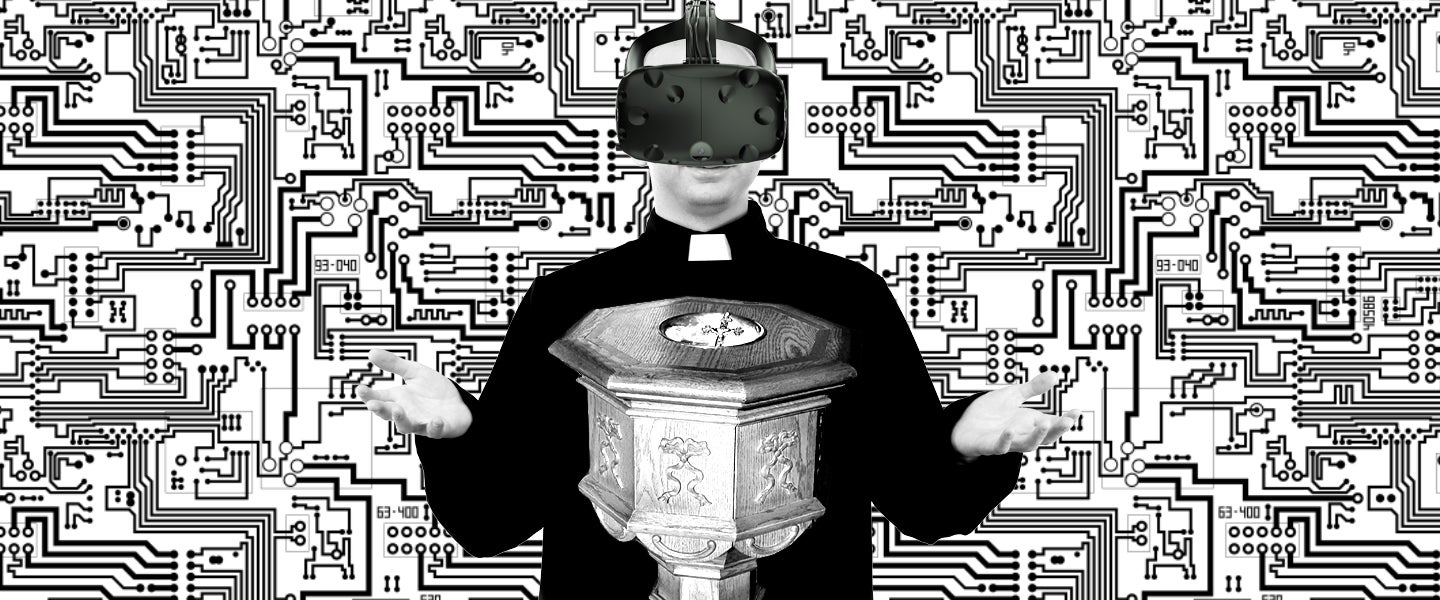In May, a video of a pink-haired anime girl getting baptized in virtual reality — while Winnie the Pooh watches — went viral. Over the course of 10 surreal minutes, the anime girl, who goes by the name Drummy, is held underwater as a priest — a man named D.J. Soto — explains the importance of baptism. The act is “meant to help people start anew with the grace of God by their side,” he claims. Eventually, Drummy comes back up from the water to cheers and loud applause from Winnie the Pooh and other VR characters (e.g., a talking cat and SpongeBob SquarePants).
Soto is a real, ordained pastor from Reading, Pennsylvania who once preached from the pulpit of a megachurch. But for a long time he felt brick-and-mortar churches were failing in their goal of spreading the word of Jesus. He told Wired that even though “holy scripture called for men of the cloth to reach into the most unreceptive corners of the world and find common ground with outsiders,” most church leaders still preferred preaching only to their existing congregations.
Soto’s initial plan was to leave Reading, travel to California and set up dozens of churches along the way. But as he and his family were making plans to move, he came across AltSpaceVR, a virtual reality social platform where anyone with an Oculus headset can become a character and go into hundreds of chat rooms to talk, play games and/or hang out with other users. For most, VR games are merely a new wrinkle to multi-player video games, but Soto saw the potential for a spiritual movement. “When we were thinking about baptism in VR, and took some time to really think about it and discuss it, and came up with the conclusion that yes, we can do baptism in virtual reality,” Soto explained to VRScout.
Since Drummy’s baptism went viral, other avatars have sought out Soto to either learn more about Christianity or convert. As such, Soto views VR environments as the “natural next step” for anyone wanting to pursue Christian missionary work. More largely, he told Wired that VR churches have the ability to “bolster flagging church attendance, particularly among the young and others who feel alienated by real world churches.”
In 2006, when the VR game Second Life allowed anyone to sign up, established churches, mosques and synagogues set up online counterparts to stream their services, build prayer spaces and meditation gardens and spread their respective messages of God. They’ve also obviously maintained an online presence via Facebook, Twitter, Instagram and Snapchat. But as VR once again becomes more popular, some Christians see Soto’s virtual church as the start of a much larger movement. “Christian transhumanism is the belief that as Christians, it’s our duty to use science and technology to make the world better,” says Micah Redding, a software developer in Nashville and the executive director of the Christian Transhumanist Association. “There’s a perception that transhumanism is anti-religion and secular, but a lot of the core tenets of Christianity are complementary to transhumanism.”
For instance, he continues, “I don’t see things like Christianity in a virtual reality context as being ‘inauthentic’ compared to the way that we think it should be practiced. If someone chooses to believe in the word of Jesus or to love Jesus in a virtual space, they don’t dissociate with their bodies, and their physical body is still given to God. So it’s still an authentic act of worship.”
“Some people might see the VR baptisms as surreal, but there’s actually a strong basis for it in Mormonism,” adds Lincoln Cannon, founder of Transfigurist, a Mormon Transhumanist advocacy group. “In Mormonism, you can practice a ‘proxy baptism,’ where you’re baptized on behalf of ancestors, with the idea being that you can do it in their place. So in a lot of ways, [VR baptism] is similar. It’s taking something that’s existed for a long time and just practicing it in a new medium. Christianity has always gone through change and adoption, and Christian leaders, emperors and philosophers, have all reconciled Christianity with the science of their time — that’s how it’s continued to exist and to thrive.”
Now, it just means that their flock will exist more as Winnie the Pooh and SpongeBob SquarePants than actual humans.

